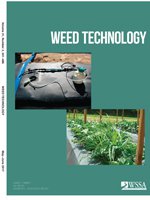If registered for use on vegetable soybean, pyroxasulfone would expand the options for weed management systems in the crop. In order to determine the potential crop injury risk of pyroxasulfone on vegetable soybean, the objective of this work was to quantify vegetable soybean tolerance to pyroxasulfone applied PRE and EPOST. Twenty-one vegetable soybean and two grain-type soybean cultivars were treated with pyroxasulfone at 417 g ai ha-1 (twice the recommended field use rate) PRE, EPOST, or not treated. Plant population density was unaffected by pyroxasulfone. Only low levels (<10%) of crop injury were observed within a few weeks after PRE and EPOST treatments. Soybean cultivars were not differentially affected by pyroxasulfone, as evidenced by the lack of interactions between cultivar and treatment for any crop response variable. The low amount of risk of crop injury associated with pyroxasulfone is no different for vegetable soybean cultivars grown in the US for commercial production than grain-type soybean.
Nomenclature: Bentazon; fomesafen; imazamox; linuron; pyroxasulfone; sulfentrazone; soybean, Glycine max (L.) Merr.





